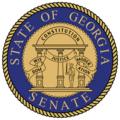Summary
| This article is part of a series on the |
| State governments of the United States |
|---|
 |
| Executive |
|
| Legislative |
(Alabama to Missouri, Montana to Wyoming) |
| Judiciary |
| Local offices |
| |
- ↑ The majority in the Alaska House of Representatives is held by a coalition of 14 Democrats, 2 Republicans and 5 Independents. The minority consists of 19 Republicans.
- ↑ The majority in the Alaska Senate is held by a coalition of 9 Democrats and 5 Republicans. There are 6 Republicans outside the caucus.
- ↑ The Constitution of California names it the "California Legislature", but the legislature brands itself as the "California State Legislature".
- ↑ The Constitution of Louisiana vests legislative authority in "a legislature, consisting of a Senate and a House of Representatives," and refers to it as "the legislature" throughout, without officially designating a term for the two houses together. However, the two bodies do use the term "Louisiana State Legislature" in official references to itself.
- ↑ There are 3 additional non-voting seats allocated to sovereign tribal nations within Maine. Since 2018, only one seat (belonging to the Passamaquoddy) is filled; the current tribal representative is a non-partisan/independent but is not counted in this total.
- ↑ When Nebraska switched to a unicameral legislature in 1937, the lower house was abolished. All current Nebraskan legislators are referred to as "Senators", as the pre-1937 senate was the retained house.
- ↑ Nebraska's legislature is de jure nonpartisan but senators' political affiliations are publicly known and voting often happens along party lines; the de facto composition is given here.
- ↑ The Constitution of Utah names it the "Legislature of the State of Utah", but the legislature brands itself as the "Utah State Legislature".
- ↑ One senator is registered with the Forward Party.
- ↑ The majority in the Vermont House of Representatives is held by a coalition of 87 Democrats, 4 Vermont Progressives and 3 independents. The minority consists of 56 Republicans.
- ↑ The majority in the Vermont Senate is held by a coalition of 16 Democrats and 1 Vermont Progressive. 13 Republicans make up the minority.
- ↑ The Constitution of Washington names it "the legislature of the state of Washington", but the legislature brands itself as the "Washington State Legislature".








